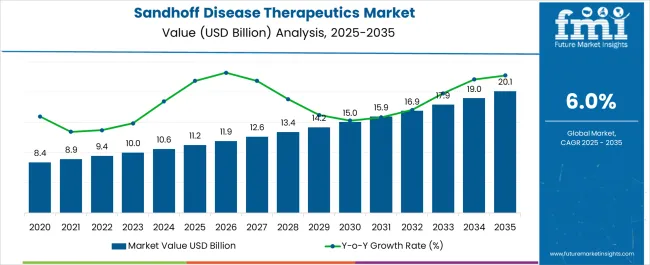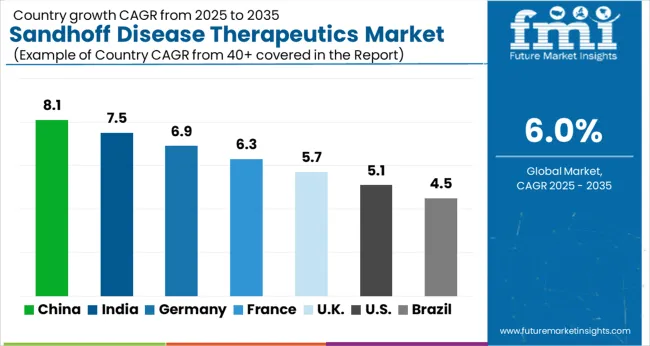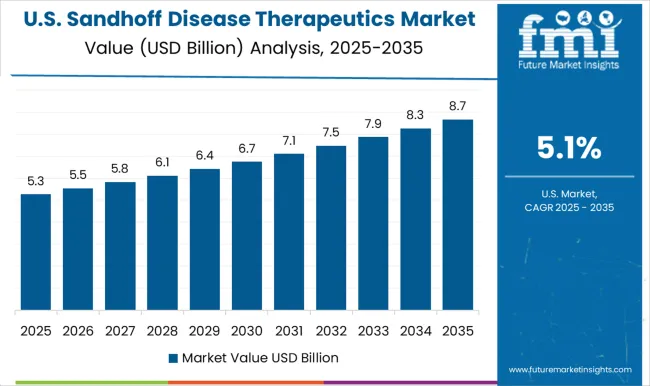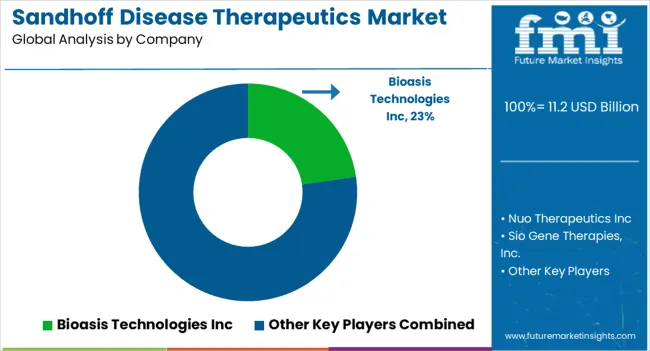The Sandhoff Disease Therapeutics Market is estimated to be valued at USD 11.2 billion in 2025 and is projected to reach USD 20.1 billion by 2035, registering a compound annual growth rate (CAGR) of 6.0% over the forecast period.

| Metric | Value |
|---|---|
| Sandhoff Disease Therapeutics Market Estimated Value in (2025 E) | USD 11.2 billion |
| Sandhoff Disease Therapeutics Market Forecast Value in (2035 F) | USD 20.1 billion |
| Forecast CAGR (2025 to 2035) | 6.0% |
The Sandhoff disease therapeutics market is witnessing accelerated development due to advancements in rare disease research, increased clinical trials, and heightened awareness of lysosomal storage disorders. Gene therapy has emerged as a major focus area, driven by its potential to address the underlying genetic cause of the disease rather than providing only symptomatic relief.
Growing investments from biotechnology firms, academic institutions, and global health organizations are supporting innovation in treatment modalities. Hospitals and specialized clinics are strengthening their infrastructure to support early diagnosis, genetic counseling, and advanced therapies for affected patients.
Regulatory incentives for orphan drug development and fast track approvals are also contributing to pipeline expansion. The outlook remains positive as emerging therapies demonstrate promise in improving quality of life and extending survival, with hospitals playing a critical role in therapeutic delivery and patient management.
Gene therapy is projected to account for 57.30% of total revenue by 2025 within the therapy category, making it the dominant segment. Growth in this area is being driven by the ability of gene therapy to target the root cause of Sandhoff disease by replacing or repairing defective genes.
Unlike conventional approaches that provide symptomatic management, gene therapy offers long term benefits and disease modifying potential. Supportive regulatory frameworks for orphan drug development and increased funding for clinical research are accelerating adoption.
The potential for one time treatment solutions has strengthened the role of gene therapy, positioning it as the most transformative therapeutic approach within the market.
The acute infantile Sandhoff disease type is expected to represent 48.60% of total revenue by 2025 within the type category, making it the largest sub segment. This dominance is due to the severity and early onset of the condition, which has heightened the demand for immediate therapeutic interventions.
Clinical research has increasingly focused on this type to improve survival outcomes and address significant unmet medical needs. Advances in molecular diagnostics have facilitated earlier detection, further driving therapeutic uptake in this patient group.
The critical nature of this condition continues to position the acute infantile type as the key focus area within Sandhoff disease therapeutics.
Hospitals are projected to hold 44.20% of total market revenue by 2025 within the end use category, making them the leading segment. This is due to their central role in providing advanced therapies, conducting clinical trials, and offering genetic counseling and supportive care.
Hospitals are often the first point of diagnosis and management for patients with Sandhoff disease, enabling comprehensive monitoring and treatment delivery. The infrastructure to handle complex therapies such as gene therapy and enzyme replacement therapy further supports their dominance.
As treatment innovations progress, hospitals remain the critical hubs for administration, monitoring, and long term patient management, solidifying their leadership in the end use segment.
According to market research and competitive intelligence provider, Future Market Insights- the market for Sandhoff Disease Therapeutics reflected a value of 4% during the historical period, 2020 to 2025.
The market for Sandhoff Disease Therapeutics is gaining prominence as it is considered a rare genetic disorder that affects the nervous system. Furthermore, due to the rarity of the disease, there is ongoing research into developing new treatments for sandhoff disease therapeutics, expected to drive demand for these treatments.
The development of new treatments is a high priority for the medical community due to the devastating effects of the disease and the limited treatment options available. As more effective treatments become available, the market for Sandhoff Disease Therapeutics is likely to grow. In the years to come, increasing focus by government organizations and private agencies like WHO and pharmaceutical companies to create awareness of Sandhoff Disease Therapeutics is fuelling the market growth. Thus, the market for Sandhoff Disease Therapeutics is expected to register a CAGR of 6% in the forecast period 2025 to 2035.
Growing advancements in diagnostic and treatment options to push the market growth
The global market for Sandhoff Disease Therapeutics is primarily driven by an increased awareness of the disease among healthcare professionals, advances in genetic testing and diagnosis, and ongoing research and development efforts towards the development of new and effective treatment options and technologies. According to the latest studies, Sandhoff disease is a rare disorder that is estimated to affect 1 in 1,000,000 individuals.
The growth of the Sandhoff Disease Therapeutics market is owed to the increasing prevalence of the condition owing to the increasing use of gene therapy, enzyme replacement therapy, and small molecule drugs. These treatments have shown promising results in preclinical and early-stage clinical trials, and if they are successful in later-stage trials and gain regulatory approval, they could significantly impact the Sandhoff disease therapeutics market. As a result, the players in the market are working on the development of new diagnostic tools and techniques that are likely to improve the accuracy of Sandhoff Disease Therapeutics.
For instance, in February 2024, Sio Gene Therapies made the announcement of the first patient being dosed with AXO-AAV-GM2, which is a significant milestone for the company as well as for the field of gene therapy. The goal of the Phase 1/2 trial is to evaluate the safety and efficacy of AXO-AAV-GM2, which has the potential to restore lysosomal enzyme activity and potentially change the course of the disease.
Expensive Cost of Treatment to restrict Market Growth
The market is projected to get significantly affected by the challenging factors such as limited availability and high cost of advanced Sandhoff Disease Therapeutics options. Expensive treatments and related costs such as hospitalization, intensive care, or specialized diagnostic tests, is expected to hinder the market growth. Furthermore, poor healthcare infrastructure, especially in developing countries, can limit access to Sandhoff Disease Therapeutics and the availability of diagnostic and therapeutic options.

Improvement in healthcare spending propelling growth of market in Asia Pacific
The South & East Asia region is expected to exhibit the significant growth rate of all regions over the forecast period, with a share of 20% during the forecast period. The growth is owed to increased awareness and prevalence of Sandhoff Disease, significant increases in healthcare spending, and the growing investments in research and development of innovative therapies in the region. South Asia is an emerging market due to the increase in point of care approach to health & care. Increasing number of hospitals in India and China makes a promising market for the market worldwide.

Increasing Focus on R&D Shaping Landscape for Sandhoff Disease Therapeutics in North America
North America is anticipated to acquire a market share of about 40% in the forecast period. This growth is attributable to the rising prevalence of the condition in the region along with the high healthcare expenditure and a large geriatric population. The United States of America holds the highest share in the North American market, followed by Canada. Presence of a large number of pharmaceutical companies, which are investing heavily in the development of new, targeted treatments for the condition, and high level of healthcare expenditure leading to a large patient population are some of the factors responsible for the growth of the market in the region.
Rising prevalence of gene therapy to push market growth
According to the studies, Gene therapy is being researched as a potential treatment for Sandhoff disease. The therapy works by introducing a functional copy of the missing enzyme into the patient's cells, thereby restoring the ability to break down GM2 ganglioside. This can potentially slow or stop the progression of the disease, and improve the patient's quality of life.
Gene therapy is still in the early stages of development and clinical trials are underway to determine its safety and efficacy. However, it has the potential to be a one-time treatment that could change the lives of patients suffering from GM2 gangliosidosis and provide a new hope for a cure.
Hospitals to take the lead and drive market growth
According to the FMI analysis, Hospitals account for the largest market share. The requirement for several hospital stays and visits during the Sandhoff Disease Therapeutics treatment facilitates the growth of this segment. Majority of the serious diseases involving the nervous system are treated in hospitals, and with the availability of trained medical personnel, it is simpler to control an individual's health more correctly.

Key players in the market include pharmaceutical companies such as Bioasis Technologies Inc, Nuo Therapeutics Inc, Sio Gene Therapies, Inc., INTRABIO IRELAND LIMITED, Sanofi, ROIVANT SCIENCES LTD, Azafaros, Polaryx Therapeutics, Abbott Medtronic, and Merck & Co., Inc. along with healthcare providers and technology companies among other global players.
| Report Attribute | Details |
|---|---|
| Market Value in 2025 | USD 11.2 billion |
| Market Value in 2035 | USD 20.1 billion |
| Growth Rate | CAGR of 6% from 2025 to 2035 |
| Base Year for Estimation | 2025 |
| Historical Data | 2020 to 2025 |
| Forecast Period | 2025 to 2035 |
| Quantitative Units | Revenue in USD Million and CAGR from 2025 to 2035 |
| Report Coverage | Revenue Forecast, Volume Forecast, Company Ranking, Competitive Landscape, Growth Factors, Trends and Pricing Analysis |
| Segments Covered | Therapy, Type, End-Users, Region |
| Regions Covered | North America; Latin America; Europe; South Asia; East Asia; Oceania; Middle East & Africa |
| Key Countries Profiled | USA, Canada, Brazil, Mexico, Rest of Latin America, Germany, United Kingdom, France, Spain, Italy, Rest of Europe, Malaysia, Singapore, China, India, Thailand, Rest of South Asia, Gulf Cooperation Council, Japan, South Korea, Australia, New Zealand, GCC countries, South Africa, Israel, Rest of MEA |
| Key Companies Profiled | NeoImmuneTech; Neurimmune; GlaxoSmithKline Plc/ Sanofi S.A.; Gilead Sciences; Inc.; Allergan Plc.; Novartis AG; AbbVie Inc.; and Bristol-Myers Squibb Company |
| Customization | Available Upon Request |
The global sandhoff disease therapeutics market is estimated to be valued at USD 11.2 billion in 2025.
The market size for the sandhoff disease therapeutics market is projected to reach USD 20.1 billion by 2035.
The sandhoff disease therapeutics market is expected to grow at a 6.0% CAGR between 2025 and 2035.
The key product types in sandhoff disease therapeutics market are gene therapy, enzyme replacement therapy and stem cell therapy.
In terms of type, acute infantile sandhoff disease segment to command 48.6% share in the sandhoff disease therapeutics market in 2025.






Our Research Products

The "Full Research Suite" delivers actionable market intel, deep dives on markets or technologies, so clients act faster, cut risk, and unlock growth.

The Leaderboard benchmarks and ranks top vendors, classifying them as Established Leaders, Leading Challengers, or Disruptors & Challengers.

Locates where complements amplify value and substitutes erode it, forecasting net impact by horizon

We deliver granular, decision-grade intel: market sizing, 5-year forecasts, pricing, adoption, usage, revenue, and operational KPIs—plus competitor tracking, regulation, and value chains—across 60 countries broadly.

Spot the shifts before they hit your P&L. We track inflection points, adoption curves, pricing moves, and ecosystem plays to show where demand is heading, why it is changing, and what to do next across high-growth markets and disruptive tech

Real-time reads of user behavior. We track shifting priorities, perceptions of today’s and next-gen services, and provider experience, then pace how fast tech moves from trial to adoption, blending buyer, consumer, and channel inputs with social signals (#WhySwitch, #UX).

Partner with our analyst team to build a custom report designed around your business priorities. From analysing market trends to assessing competitors or crafting bespoke datasets, we tailor insights to your needs.
Supplier Intelligence
Discovery & Profiling
Capacity & Footprint
Performance & Risk
Compliance & Governance
Commercial Readiness
Who Supplies Whom
Scorecards & Shortlists
Playbooks & Docs
Category Intelligence
Definition & Scope
Demand & Use Cases
Cost Drivers
Market Structure
Supply Chain Map
Trade & Policy
Operating Norms
Deliverables
Buyer Intelligence
Account Basics
Spend & Scope
Procurement Model
Vendor Requirements
Terms & Policies
Entry Strategy
Pain Points & Triggers
Outputs
Pricing Analysis
Benchmarks
Trends
Should-Cost
Indexation
Landed Cost
Commercial Terms
Deliverables
Brand Analysis
Positioning & Value Prop
Share & Presence
Customer Evidence
Go-to-Market
Digital & Reputation
Compliance & Trust
KPIs & Gaps
Outputs
Full Research Suite comprises of:
Market outlook & trends analysis
Interviews & case studies
Strategic recommendations
Vendor profiles & capabilities analysis
5-year forecasts
8 regions and 60+ country-level data splits
Market segment data splits
12 months of continuous data updates
DELIVERED AS:
PDF EXCEL ONLINE
The lung disease therapeutics market is segmented by disease type, treatment type and distribution channel from 2025 to 2035
Pleural Diseases Therapeutics Market – Drug Trends & Future Outlook 2025 to 2035
Autoimmune Disease Therapeutics Market Analysis – Size, Share, & Forecast Outlook 2025 to 2035
Marburg Virus Disease Therapeutics Market - Growth & Vaccine Advances 2025 to 2035
Niemann-Pick Disease Type C Therapeutics Market
Rosai-Dorfman Disease (RDD) Therapeutics Market Size and Share Forecast Outlook 2025 to 2035
Pelvic Inflammatory Disease Therapeutics Market
Veterinary Infectious Disease Therapeutics Market
Veno-Occlusive Hepatic Disease Therapeutics Market Size and Share Forecast Outlook 2025 to 2035
Paediatric Respiratory Disease Therapeutics Market
Gastroesophageal Reflux Disease Therapeutics Market Analysis - Innovations & Forecast 2025 to 2035
Late Stage Chronic Kidney Disease Therapeutics Market Size and Share Forecast Outlook 2025 to 2035
Disease Resistant Mask Market Analysis - By Type, Material, End-User, Distribution Channel, and Region - Trends, Growth & Forecast 2025 to 2035
Biotherapeutics Virus Removal Filters Market Trends – Growth & Forecast 2025 to 2035
Rare Disease Clinical Trials Market Size and Share Forecast Outlook 2025 to 2035
COPD Therapeutics Market Report – Growth, Demand & Industry Forecast 2023-2033
Rare Disease Gene Therapy Market
Swine Disease Diagnostic Kit Market Size and Share Forecast Outlook 2025 to 2035
Liver Disease Diagnostics Market Size and Share Forecast Outlook 2025 to 2035
Fabry Disease Market Size and Share Forecast Outlook 2025 to 2035

Thank you!
You will receive an email from our Business Development Manager. Please be sure to check your SPAM/JUNK folder too.
Chat With
MaRIA